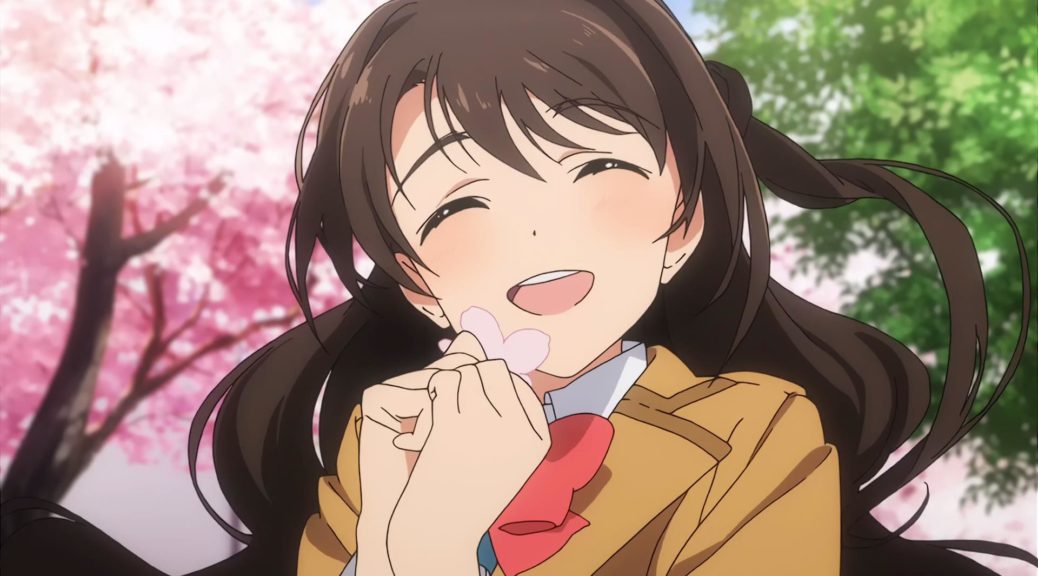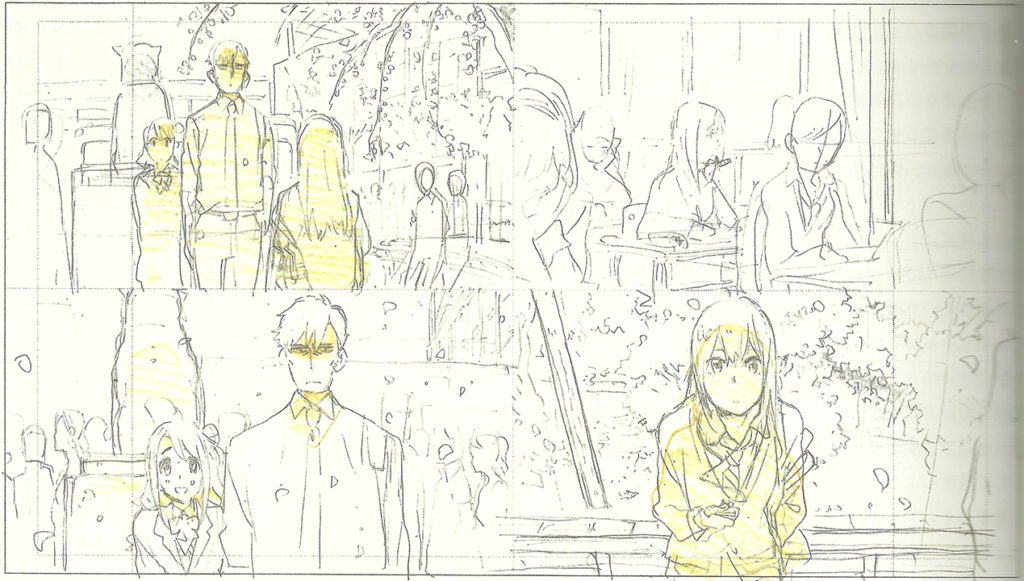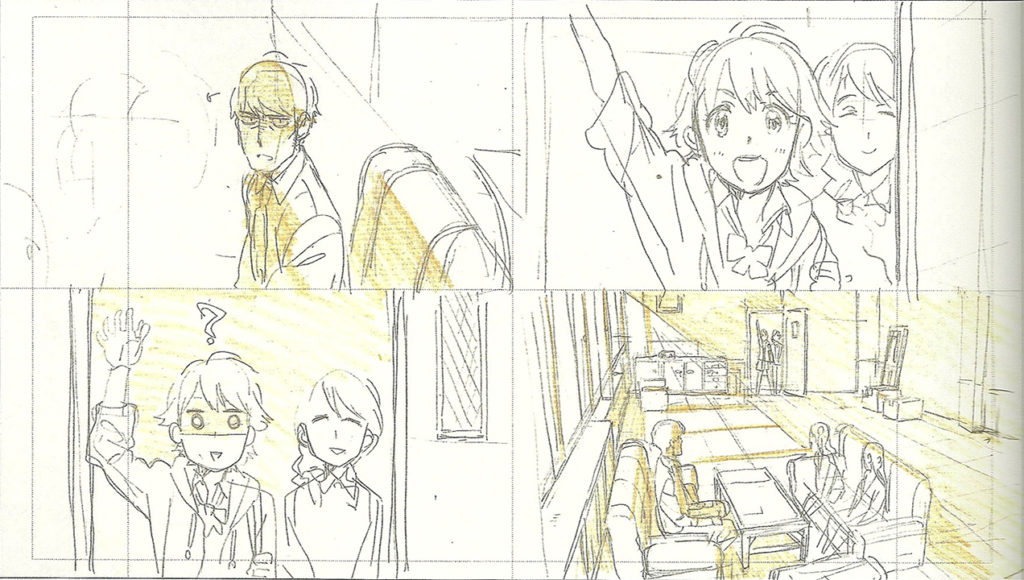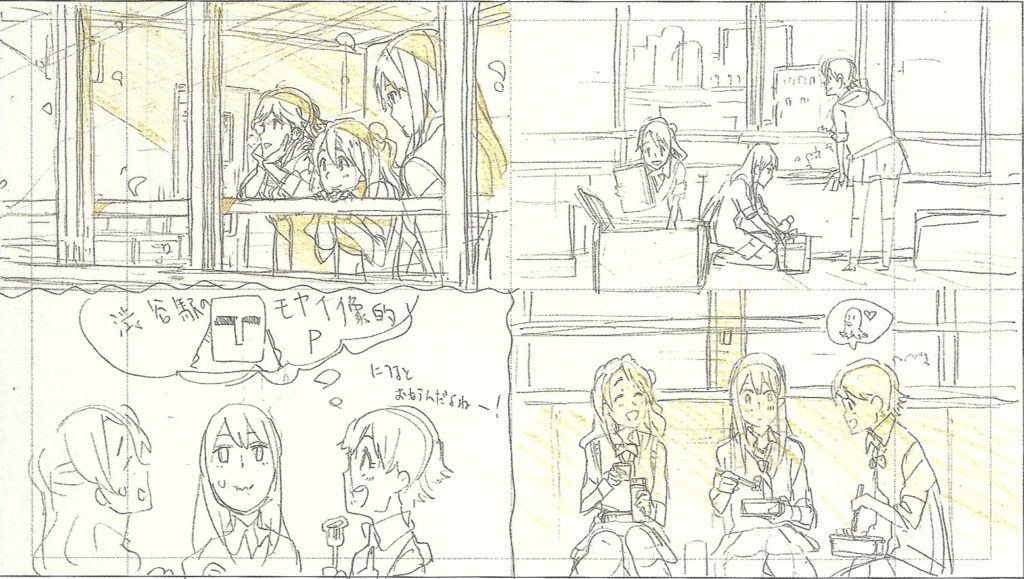
The iDOLM@STER Cinderella Girls Staff Interviews – Noriko Takao x Atsushi Nishigori Roundtable Part 1
The Cinderella Girls fanbook is a treat for fans that’s blessed not only with a beautiful cover by the god Fugo himself, but also with a ton of meaty interviews with both the cast and most of the production staff involved. It’s only natural then that — as the guy who lives and breathes imas around these parts — I take the task upon myself to translate a number of said interviews for the sake of all you lovely folk out there, and there’s no better way to begin than with a very interesting (and long!) interview with both Noriko Takao and Atsushi Nishigori, the duo responsible for the two very impressive adaptations.
Enough chatter from the rabid fan though, let’s fire into the first half of this beast.
Noriko Takao: Started off at Kyoto Animation in the early 00s, where she got promoted to storyboarder and episode director in 2006. Eventually became one of their stronger directors, but decided to leave to become freelance in 2011 so that she could direct her own series. Ever since then she’s been attached to A-1 and Aniplex projects like The iDOLM@STER and Saint Young Men.
Atsushi Nishigori: Joined the industry through Gainax after graduating from the Toei Animation Institute. Eventually became one of their character designers for series like Gurren Lagann and Panty & Stocking, but also went freelance to work on The iDOLM@STER because he’s a massive nerd who loves the franchise to bits. Maintains links to Trigger even nowadays.
— Let’s kick things off by asking for your thoughts on the finished product, Nishigori.
Nishigori: In all honesty, I felt that the Cinderella Girls adaptation (Dereani from here on) had to differentiate itself substantially from the 2011 anime (Animas from here on), otherwise there wouldn’t have been any point in making it. Couple that with my desire to see Takao’s work from a regular viewer’s perspective, and you’ve got my reasoning for actively avoiding as much involvement with it as I could. Obviously I had faith in her ability to pull it off too, so I was pretty set in my ways despite the team badgering me to help out. You could say I’m being a wee bit biased here since the whole situation felt reminiscent of watching over your little sister’s hard work, but there’s no doubt in my mind that she knocked it right out of the park.
In fact, seeing what she managed to accomplish left me feeling pretty frustrated with myself in the end.
— Oh? Would you mind going a bit more in-depth on that?
Nishigori: Well, there were a number of points during Animas where I struggled to properly convey the things I wanted to, leading me to give up for the time being in the hopes of learning how to remedy that in the future. Meanwhile, Takao tackled any and all challenges head on, eventually overcoming them and coming out all the better for it. Whether or not she was as critical of her own work as I was isn’t for me to say, but the fact remains that she did what I couldn’t, and that reality hit me pretty hard.
On the flip side though, that’s just all the more proof that she really did create something special.
Takao: I found myself immediately worried when the idea of me directing Dereani got brought up; not only did I have a lot of fun working on Animas, but I’d also become super attached the 765 girls. How, then, was I going to take on the challenge of working with an entirely new cast that I had no attachment to? That was a serious concern at the beginning, but fortunately Nishigori sat rather close to me at the time, so we had the chance to talk things out now and then.
— I see.
Takao: It was during those talks that he told me to prioritise my own vision over everything else, which prompted me to think long and hard about my vision for the new idols I’d be getting to know.
— You really had to consider everything from the ground up then, it seems.
Takao: The conclusion I eventually reached was that, even if we’re focusing on a new cast, this is still the same imas world that we know and love. Said world has a sense of compassion and kindness at its very core, a fact which I believe applies throughout the entire franchise. That’s why I chose to stick with the theme of girls chasing their dreams while receiving support from their producer, because otherwise it just wouldn’t feel like imas.
…Sorry, I got a bit carried away there.
— No worries, haha.
Takao: Having figured all that out, the next step was learning about the characters and deciding what kind of story I wanted to tell based on my impressions of them. Staying true to that compassion and kindness I mentioned, while also making it clear that I didn’t want to make any compromises in the creative process, ended up being a key factor in how the show turned out the way it did.
— Tell us then, what do you think the main differences between Dereani and Animas are?
Takao: The first difference, and probably the most major one, is how things kick off for the girls in Dereani. In Animas we’re introduced to a cast who already understand the mentality behind being an idol; they may not have fully developed yet, but they have both the drive and the talent to do so. Meanwhile in Dereani, true to the “Cinderella” name, a number of the cast haven’t even reached that stage yet. It’s similar to the game in that respect, where the girls you’re scouting off the street can blatantly tell you they’re not interested in the idol business, or you can end up pulling girls in from completely different professions.
Another difference is the environment the Dereani girls work in. While more of a blank slate compared to their Animas counterparts, they’ve also been blessed with the opportunity to work for a much larger scale production. Granted, said production’s size does come at the cost of less freedom.
— So Dereani’s starting point involves the cast taking their first step towards becoming idols.
Takao: One of my main goals was to portray them as girls who honestly believed their hard work would pay off in the end, resulting in a story where the viewers can’t help but want to cheer them on and see them succeed. To that effect, it might be more appropriate to call them princesses rather than idols.
Nishigori: One major thing I noticed while watching Dereani was the obvious contrast in our directing styles. Takao takes way more care in setting up major scenes and exploring cast members’ characters, for example. Then you’ve got me, the guy who just kinda brute forces it, haha. I started out as an artist too, so I’ve always been fond of just going at it without giving the details too much thought and letting others piece together what I want to get across. Meanwhile, breaking down every aspect of the process and using it all to guide the viewer along’s been a key component in Takao’s direction for a long time now, noticeable even on her work during Animas, and watching Dereani’s intro scenes helped me reaffirm that I’d never be able to pull something like that off.
Admittedly though, I did find myself wondering if she really was planning on sticking with that style all the way from beginning to end, haha.
Takao: If there’s anything I learned from working on Animas with you, it’s that coming to care for the girls is a major part of the imas franchise as a whole. There’s all sorts of ways you can do that too, which ends up being part of the fun, especially when the sheer number of them doesn’t get in the way of them having their own unique traits, haha. It did make deciding on where to take things a lot more difficult than usual, but again, that’s part of the fun in the end.
All in all, our work on Animas had a significant impact on how I went about things for Dereani. In fact, I should probably apologise to you since it feels like I took the easy way out, haha.
Nishigori: No need, haha.
Takao: Considering the things we accomplished with Animas though, I do think that influence ended up being beneficial for Dereani in the long run. Especially in regards to how we used the new Producer.
Nishigori: There were some concerns over how to handle his character at the beginning, that’s for sure. imas doesn’t really fall into the harem category, but even then it’s hard to convince certain viewers to care for a male character in a show largely dominated by girls; that’s one of the reasons Animas’s Producer ended up the way he did. Thing is though, we couldn’t really repeat that with Dereani’s Producer since it’d run the risk of him just fading into the background, so that lead to a discussion about taking his character in a different direction.
— I take it you were the go to person when Takao needed advice?
Nishigori: We just had a couple of talks now and then, so I wouldn’t go that far.
I have to admit though, I couldn’t hide my surprise when I saw the rough design she came up with for the new Producer. But pleasantly so! It’s the sort of design most guys wouldn’t even give a second thought to, so I could tell right away that it had the potential to lead to interesting material. Most of you might agree with me now since you already know he’s an interesting character through context of having seen the show, but it probably would’ve set off alarm bells in your heads at the time when coupled with the lines he had.
Takao: It doesn’t help that you couldn’t attach a voice to the design and lines back then, haha.
Nishigori: For sure, haha.
In fact, Takao was the only one who had a solid grasp on his character for a while, so she had to go around convincing everyone that this was the right direction to go in. Having the resolve to do that’s pretty important for a writer I’d say, and what’s more, she managed to get through to them in the end as well. That’s an especially impressive feat considering designs people aren’t used to are more likely than not to get shot down right out of the door, even more so when the show’s main focus is on the girls. Sticking with what you know’s generally the motto, but Takao didn’t back down in the face of that mentality, which is why I’ve got nothing but praise for her.
Takao: You certainly weren’t shy when it came to sharing your input at the time, haha.
Nishigori: That was just me taking advantage of the fact that I wasn’t directly involved with the project, haha.
Honestly though, that first episode really was incredible. Not only did it do a fantastic job of drawing the line between Dereani from Animas, but it gave the Producer a strong and unique character right from the get-go. That’s not something everyone can pull off in a single episode.
— As you know, we’re planning on including your image boards for the show along with this interview, so allow me to ask: did coming up with a design for the new Producer prove to be an easy task?
Takao: It actually was rather easy, mainly because my first priority involved deciding on which characters would have the most significance within Dereani. My ideal image of him was already alive and kicking by the time I’d settled on having the story centre around new generations, largely due to how tame the three of them are, haha. People tend to call Mio a troublemaker and whatnot, but she’s actually a pretty bright girl, even if she does have a tendency to go on tilt whenever circumstances get the best of her. She’s no slouch when it comes to schoolwork, and she’s as athletic as they come too; not only that, but she has a knack for raising everyone’s spirits when they’re down in the dumps. Then you’ve got Uzuki who’s…well, Uzuki. Pure and earnest to her core, it’s not often she’ll give someone no for an answer. Even Rin’s fairly normal despite what first impressions may lead you to think about her.
This is why I chose to give the Producer his own special quirk instead: kind-hearted though he may be, his main issue lays in communicating properly with the girls he’s producing. That unfortunate quirk of his served as a solid point from which to have the drama begin, and is the main reason I designed him the way I did.
— That’s rather interesting.
Takao: While Cinderella Girls is all about the cast and their efforts to live out their own Cinderella story, it’s down to the Producer to invite them into the industry and guide them along the way. Therein lies the rub, though, because he kind of sucks at the whole communication with others thing, haha.
But yeah, it’s safe to say that he was conceptualised from a woman’s standpoint first and foremost.
— I have to say, you definitely strike me as the kind of person who forms a coherent plan and sticks to it based on what I’ve heard so far.
Takao: The shocking truth is that I threw ideas in and took others out on the fly, haha.
Nishigori: That’s how the creative process generally goes, haha.
Takao: I wasn’t any stranger to finishing up a meeting, getting home, crawling into bed and then just thinking about other things we could do, to say the least.
Nishigori: Planning things out rigorously and sticking to that’s one way to do it, but that doesn’t guarantee you’ll have something interesting on your hands. That’s why — so long as the initial planning provides you with a solid foundation — I think it’s fine to add and/or remove stuff as you go.
Takao: The fact of the matter is that you can’t really go above and beyond your initial ideas if you get too invested in not deviating from the plan, and if that results in you not being able to get excited over your own work, then don’t expect the viewers to find themselves thrilled either. I say this because — during the times I do get trapped by the idea that deviation is bad — I really struggle to break free from it myself. I’ve even made it a personal goal to avoid letting that thought process take over as much as I can.
Nishigori: Real talk though, that side of you’s definitely got its positive aspects as well. I can tell you right now that there were plenty of times where I found myself surprised at how much I learned about certain characters during Animas thanks to your input on my work.
Takao: Let’s not exaggerate now, haha.
Nishigori: In the end, I’d say that a person’s aversion towards straying from the plan comes from a need to maintain peace of mind. You’re the only one who can decide on what the right choice is, so it’s important to trust your heart and allow that to influence your work. Dereani, for example, struck a fine balance through the Cinderella concept serving as its foundation, but also allowing itself to be influenced by Animas. Takao also made sure to stay true to her own personal standards throughout it, which worked out well.
Takao: Ishihara (Akihiro) personally requested that the Cinderella theme remain an essential part of the anime as well, so that ended up serving as the foundation for everything else. I was actually thankful that he did so too, since I tend to work far better when given a direction like that over just being told I can do whatever.
Nishigori: You can see that theme come through a lot on the design front, too. The main font, for example, ended up being nice and elegant, as opposed to Animas’s rough, gothic style font.
Admittedly I did find that kind of funny since it clashes with my belief that Takao’s more of a badass lady than an elegant one, haha.
— Ahaha.
Nishigori: Silly comments aside though, I appreciate the fact that you can feel Takao’s influence throughout Dereani. It’s always nice to watch shows where the director chooses to focus on their own preferences over having them take a back seat, and it’s apparent Takao had no issue pursuing her own vision over pumping out something overly light-hearted. The way she handles and develops the drama — especially throughout the second cour — is a testament to that which, as a fan of her work, left me completely satisfied.
Takao: I’m not sure I deserve that much praise, haha.
Nishigori: Honestly, the pacing and way each cut builds upon the last had me on the edge of my seat pretty often. There’s no way that wasn’t all planned out.
Takao: You think? (Laughs)
Nishigori: Well who knows, maybe you’re just at the point where you pull off that kind of work subconsciously. Even then though, there’s always a tendency for the direction and visuals to speak over the dialogue itself in your work, especially in terms of character presentation and pacing. Dereani alone’s chock full of examples too, even during the first half.
Takao: It’s probably more accurate to say that’s the only way I know how to do it, haha. It helps that the rest of the staff went full throttle right from the get-go, too. In fact, I was both surprised and really happy to learn just how understanding they were. Lots of them worked together with us on Animas as well, and the animators were especially eager about wanting to deliver something even better than what we pulled off there.
Phew, I really wasn’t joking when I said this was a long one. Lots of interesting info here though, especially in regards to TakeP! The second part’s just as interesting, and is already fully TL’d, so look forward to reading the rest tomorrow!
If you find yourself interested in picking up the Dereani fanbook, then here’s a handy link for you. There’s an insane amount of content in it, so definitely worth the purchase!
Support us on Patreon so that we can keep producing content like this, and move the entirety of Sakugabooru to an independent server.



I can not believe I found this jewel hidden at the bottom of this page.
I just wanted to see the beginning of the Blog I never thought I’d find anything related to Idolmaster Cinderella Girls.
This is like Christmas and birthday at the same time I can not wait to read more
Noriko Takao was also the storyboard artist and episode director for the Tomoyo and Kyou Clannad OVA’s.